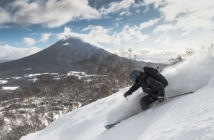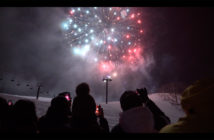Photography is one of the most important things in my life, and I’ve been lucky enough to shoot around Niseko for the past 6 seasons. I’ll help explain some of the tricks of the trade for getting great photos on the mountain, and how to take care of your gear in harsh alpine environments.
What to take with you:
You may be surprised to know that most SLR cameras are quite weather resistant; even the base models do have some level of weather resistance. SLR cameras are built to last, even in harsh environments. That said, even the most rugged of cameras are still prone to the weather here in Niseko, but these simple tips will make life a lot easier.
If it’s dumping with snow, it can be difficult to keep the snow off the glass of your lens and viewfinder. Whatever you do, don’t blow the snow off your lens with your mouth— you’ll only heat it up and make it worse. The solution to this is to carry a rubber hand-puffer in your bag or pocket. If it’s snowing and below freezing, the snow won’t completely stick to your gear, so a puff of cold air will easily dislodge any excess snow.
Make sure you take a sturdy padded camera bag out with you. There are many different sizes and shapes available, and they all have their advantages and disadvantages. I would recommend one that will fit just the basic gear you’re likely to take out on the hill at any one time. For example, I carry a bag that has room for one camera body with a telephoto lens, as well as a wide lens or fisheye. Make sure to use one that has two shoulder straps, as well as waist and chest clips— wearing your bag securely will help you to ski around better, so you’ll be less likely to fall and damage your camera.
Photography Equipment:
My telephoto Canon 70-200mm f/2.8 lens is definitely my go-to lens for alpine shooting. I have done more shots with this lens than almost all of my other lenses combined. This is a great focal length lens with great sharpness and reliably fast auto focus. If you don’t already have a lens like this and you’re serious about photography; get one. It’s one of the most useful lenses available.
I like to take my wide-angle Canon 17-40mm f/4 lens for a variety of wide action shots and general landscapes. It’s great to get a different perspective and show the environment that you’re in. When you’re shooting landscapes with wide lenses, get low to the ground and get something interesting in the foreground; like a snow covered tree, or some ripples in the snow.
Try to carry the minimum amount of photography equipment with you at any one time. This will reduce your weight so you can ski around better and access more terrain. I try to take just one camera body with 3 lenses— my telephoto lens attached to my camera body, a wide-angle lens, and a fisheye lens. Although this is what I take out with me on most shoots, feel free to try your own lens combinations and see what works for you.
Setting up the Shot:
The first step to getting a great action shot in the snow is finding a sweet line with fresh, untracked snow. Try to find a line in a more open kind of area. If the trees are too tight your skier might be hidden behind trees in all of the photos. Once you’ve found a suitable spot, talk to your skier about exactly where you want them to go; communication is vital.
Whenever you remove your camera from your bag, make sure to close up your bag again and put it on your back. You’ll want to ensure that you don’t get any excess snow in there, and that you can move out of the way if something unexpected happens.
Getting your exposure right can be a bit tricky in the snow. Your camera’s auto exposure will often expect an average amount of light, and snow reflects much more light than cameras expect. As a result, the auto exposure will often create an image much darker than it should be. If you’re shooting on aperture or shutter speed priority, get the right exposure by playing with the exposure compensation dial. Take a photo of a friend’s colored jacket, and if what you see on the screen is pretty close to what you see in real life, you’ve got about the right exposure.
A common angle that is particularly easy for novice photographers is to shoot directly up from the bottom of the skiable line with a telephoto lens. You can get some great straight-on shots of your skier without the snow completely covering their face. Another great shot is to put on a wide-angle lens and have them do one big deep turn around you while you shoot a burst of images.
Keep on shooting and playing around with different angles. Stay safe and enjoy the amazing landscape that Niseko has to offer!
Tip: Remember to tell your ski model not to spray you with snow! You don’t get a good photo, you get covered in snow, and then you have to spend the next couple of minutes blowing the snow off your gear with your puffer.
Tip: When you get home from a day of shooting, open up your bag and take everything out of it. Put everything on a dry towel in a room with a heater. This will ensure that there is no excess moisture in any of your gear that may cause fogging or failure.




